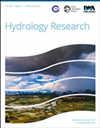通过地理信息系统、遥感和频率比模型绘制通戈巴萨流域洪水易发区地图
IF 2.4
4区 环境科学与生态学
Q2 Environmental Science
引用次数: 0
摘要
洪水是杜阿拉市居民,特别是通戈巴萨流域(TBW)居民面临的一个主要问题。面对这种情况,公共当局需要制定措施,减轻居民在这些灾害面前的脆弱性。本文旨在利用地理信息系统、实地数据(历史洪水点)、遥感数据(哨兵 II 图像)和频率比模型绘制通戈巴萨流域洪水风险区域图。绘制的地图显示,流域面积的 1.41%、8.88%、28.51%、33.86% 和 27.33%分别被划分为极低、低、中、高和极高洪水脆弱性等级。高洪水风险区和极高洪水风险区(最有可能发生洪水的地区)占流域面积的一半以上(61.19%)。这些地区的特点是严重不透水、海拔低、坡度弱、非常靠近水道以及土壤粘重。盆地中的大部分房屋(66.92%)都位于受这两种程度(高和极高)影响的地区。由于成功率和预测准确率分别为 89% 和 96.78%,因此对所绘制的洪水风险区地图有一定的信心。本文章由计算机程序翻译,如有差异,请以英文原文为准。
Flood susceptibility mapping in the Tongo Bassa watershed through the GIS, remote sensing and the frequency ratio model
Flooding constitutes a major problem for the inhabitants of Douala City in general and those of the Tongo Bassa watershed (TBW) in particular. Faced with this situation, public authorities need to put in place measures to mitigate the vulnerability of populations to these disasters. This article aims to map flooding risk areas in the TBW using the geographic information system, field data (historical flood points), remote sensing data (Sentinel II image) and the frequency ratio model. The map produced shows that 1.41, 8.88, 28.51, 33.86 and 27.33% of the basin area are respectively delimited into very low, low, medium, high and very high flood vulnerability classes. High and very high flooding risk areas (those where flooding is most likely to occur) occupy more than half of the basin (61.19%). These areas are characterized by significant imperviousness, low altitudes, weak slopes, significant proximity to watercourses and clayey soils. Most of the houses in the basin (66.92%) are located in areas affected by these two levels of exposure (high and very high). With respective success and prediction accuracy rates of 89 and 96.78%, a certain confidence deserves to be placed on the map of flooding risk areas produced.
求助全文
通过发布文献求助,成功后即可免费获取论文全文。
去求助
来源期刊

Hydrology Research
Environmental Science-Water Science and Technology
CiteScore
5.30
自引率
7.40%
发文量
70
审稿时长
17 weeks
期刊介绍:
Hydrology Research provides international coverage on all aspects of hydrology in its widest sense, and welcomes the submission of papers from across the subject. While emphasis is placed on studies of the hydrological cycle, the Journal also covers the physics and chemistry of water. Hydrology Research is intended to be a link between basic hydrological research and the practical application of scientific results within the broad field of water management.
 求助内容:
求助内容: 应助结果提醒方式:
应助结果提醒方式:


